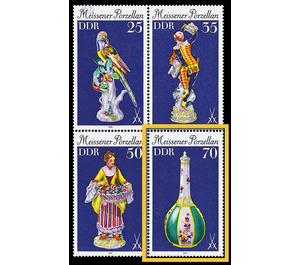Commemorative stamp series - Germany / German Democratic Republic 1979 - 70 Pfennig
Theme: Art & Culture
| Country | Germany / German Democratic Republic |
| Issue Date | 1979 |
| Face Value | 70.00 |
| Color | blue |
| Perforation | K 14 |
| Printing Type | Rotogravure 2 |
| Stamp Type | Postage stamp |
| Item Type | Stamp |
| Chronological Issue Number | 2213 |
| Chronological Chapter | GER-DDR |
| SID | 856608 |
| In 12 Wishlists | |
Meissen Porcelain With a selection of motifs from the historical and current production of the Meissen Porcelain Manufactory, the Ministry of Posts and Telecommunications of the German Democratic Republic publishes two multi-colored se-tenants, each with four special postage stamps. No special first-day cover envelope 70-pfennig value: Sake bottle Shape: East Asian model Decor: "Indian flower painting", gold edge painting and green background surfaces The shape of this eight-sided sake bottle (Japanese rice wine) is already produced in the first years of existence of the manufactory still predominantly oriented on East Asian forms or copied these. It was only with the work of the Dresden goldsmith J. J. Irminger and above all with the work of J. J. Kaendler that the European formal language in porcelain began to develop and assert itself. Especially the rococo style became typical of "Meissen" and established its fame.


